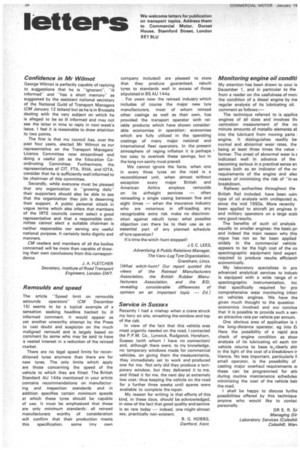Monitoring engine oil conditi
Page 40

If you've noticed an error in this article please click here to report it so we can fix it.
My attention has been drawn to your is December 1, and in particular to the from a reader on the usefulness of mon the condition of a diesel engine by me regular analysis of its lubricating oil. comment as follows:—
The technique referred to is applica engines of all sizes and involves thi centration measurement of the no minute amounts of metallic elements at into the lubricant from moving parts engine. It distinguishes readily be normal and abnormal wear rates, the being at least three times the value former. The onset of abnormal wear is a indicated well in advance of the becoming serious in a practical sense an serves both as an indicator of the ov requirements of the engine and also means of minimizing the risk of "in-se breakdown.
Railway authorities throughout the British Rail included, have been usin type of oil analysis with undisputed a since the mid 1950s. More recently been applied to aircraft jet engines b and military operators on a large scali very good results.
The benefits of such oil analysis equally to smaller engines: the basic pr and indeed the main reason why this nique has not so far been applied widely in the commercial vehicle appears to be the high cost of the co spectrographic equipment (and expert required to produce results efficient!, economically.
My laboratory specializes in pro advanced analytical services to industi is equipped with a wide range of nspectrographic instrumentation, inc that specifically required for pro comprehensive wear monitoring inforr on vehicles engines. We have the given much thought to the question economics involved and our conclus that it is possible to provide such a sen an attractive rate per vehicle per annum.
One obvious area of application is t the long-distance operator, eg into Ei Here the possibility of a rapid ana check of engine condition as shost analysis of its lubricating oil each tin' vehicle returns to base is clearly attr in the light of the cost of a breakdown ir Vienna. No less important, particularly fi small operator, is the possibility of casting major overhaul requirements sc these can be programmed for att( during routine maintenance schedules minimizing the cost of the vehicle beil the road.
I shall be happy to discuss furthe possibilities offered by this technique anyone who would like to contac personally.
DR E, R. Si Managing OnLaboratory Services (Coleshil, Co/es/till, WarL




















































































































